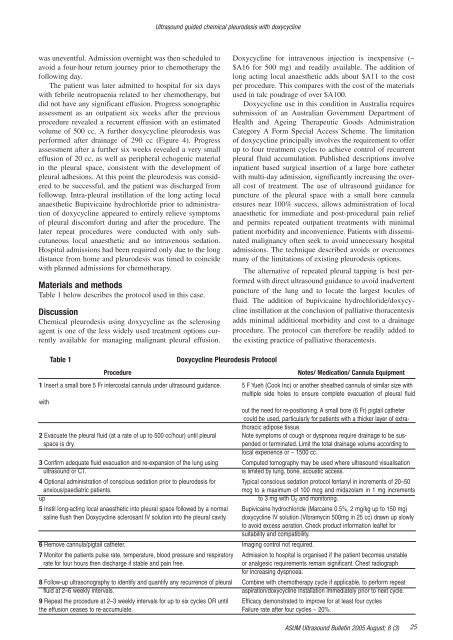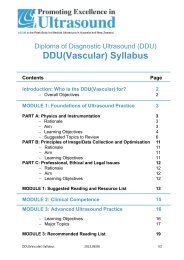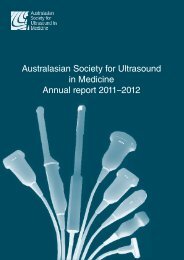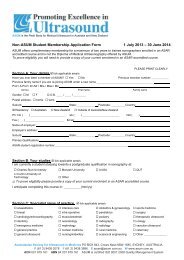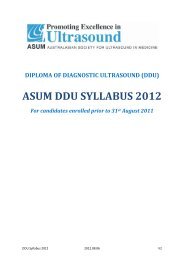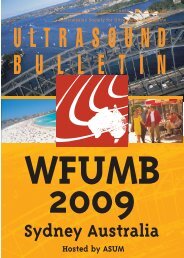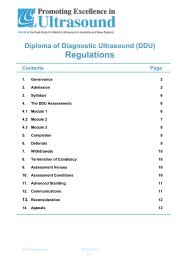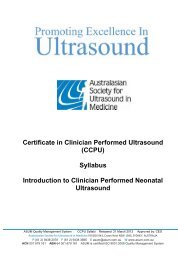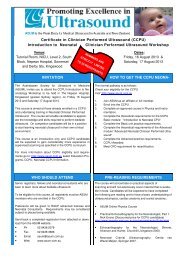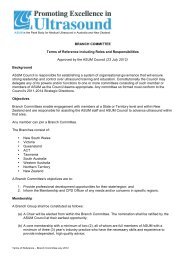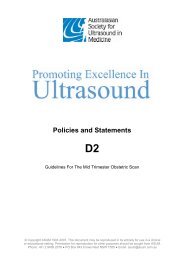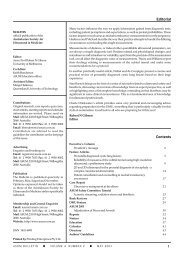Volume 8 Issue 3 - Australasian Society for Ultrasound in Medicine
Volume 8 Issue 3 - Australasian Society for Ultrasound in Medicine
Volume 8 Issue 3 - Australasian Society for Ultrasound in Medicine
Create successful ePaper yourself
Turn your PDF publications into a flip-book with our unique Google optimized e-Paper software.
<strong>Ultrasound</strong> guided chemical pleurodesis with doxycycl<strong>in</strong>ewas uneventful. Admission overnight was then scheduled toavoid a four-hour return journey prior to chemotherapy thefollow<strong>in</strong>g day.The patient was later admitted to hospital <strong>for</strong> six dayswith febrile neutropaenia related to her chemotherapy, butdid not have any significant effusion. Progress sonographicassessment as an outpatient six weeks after the previousprocedure revealed a recurrent effusion with an estimatedvolume of 500 cc. A further doxycycl<strong>in</strong>e pleurodesis wasper<strong>for</strong>med after dra<strong>in</strong>age of 290 cc (Figure 4). Progressassessment after a further six weeks revealed a very smalleffusion of 20 cc, as well as peripheral echogenic material<strong>in</strong> the pleural space, consistent with the development ofpleural adhesions. At this po<strong>in</strong>t the pleurodesis was consideredto be successful, and the patient was discharged fromfollowup. Intra-pleural <strong>in</strong>stillation of the long act<strong>in</strong>g localanaesthetic Bupivica<strong>in</strong>e hydrochloride prior to adm<strong>in</strong>istrationof doxycycl<strong>in</strong>e appeared to entirely relieve symptomsof pleural discom<strong>for</strong>t dur<strong>in</strong>g and after the procedure. Thelater repeat procedures were conducted with only subcutaneouslocal anaesthetic and no <strong>in</strong>travenous sedation.Hospital admissions had been required only due to the longdistance from home and pleurodesis was timed to co<strong>in</strong>cidewith planned admissions <strong>for</strong> chemotherapy.Materials and methodsTable 1 below describes the protocol used <strong>in</strong> this case.DiscussionChemical pleurodesis us<strong>in</strong>g doxycycl<strong>in</strong>e as the scleros<strong>in</strong>gagent is one of the less widely used treatment options currentlyavailable <strong>for</strong> manag<strong>in</strong>g malignant pleural effusion.Doxycycl<strong>in</strong>e <strong>for</strong> <strong>in</strong>travenous <strong>in</strong>jection is <strong>in</strong>expensive (~$A16 <strong>for</strong> 500 mg) and readily available. The addition oflong act<strong>in</strong>g local anaesthetic adds about $A11 to the costper procedure. This compares with the cost of the materialsused <strong>in</strong> talc poudrage of over $A100.Doxycycl<strong>in</strong>e use <strong>in</strong> this condition <strong>in</strong> Australia requiressubmission of an Australian Government Department ofHealth and Age<strong>in</strong>g Therapeutic Goods Adm<strong>in</strong>istrationCategory A Form Special Access Scheme. The limitationof doxycycl<strong>in</strong>e pr<strong>in</strong>cipally <strong>in</strong>volves the requirement to offerup to four treatment cycles to achieve control of recurrentpleural fluid accumulation. Published descriptions <strong>in</strong>volve<strong>in</strong>patient based surgical <strong>in</strong>sertion of a large bore catheterwith multi-day admission, significantly <strong>in</strong>creas<strong>in</strong>g the overallcost of treatment. The use of ultrasound guidance <strong>for</strong>puncture of the pleural space with a small bore cannulaensures near 100% success, allows adm<strong>in</strong>istration of localanaesthetic <strong>for</strong> immediate and post-procedural pa<strong>in</strong> reliefand permits repeated outpatient treatments with m<strong>in</strong>imalpatient morbidity and <strong>in</strong>convenience. Patients with dissem<strong>in</strong>atedmalignancy often seek to avoid unnecessary hospitaladmissions. The technique described avoids or overcomesmany of the limitations of exist<strong>in</strong>g pleurodesis options.The alternative of repeated pleural tapp<strong>in</strong>g is best per<strong>for</strong>medwith direct ultrasound guidance to avoid <strong>in</strong>advertentpuncture of the lung and to locate the largest locules offluid. The addition of bupivica<strong>in</strong>e hydrochloride/doxycycl<strong>in</strong>e<strong>in</strong>stillation at the conclusion of palliative thoracentesisadds m<strong>in</strong>imal additional morbidity and cost to a dra<strong>in</strong>ageprocedure. The protocol can there<strong>for</strong>e be readily added tothe exist<strong>in</strong>g practice of palliative thoracentesis.Table 1Doxycycl<strong>in</strong>e Pleurodesis ProtocolProcedureNotes/ Medication/ Cannula Equipment1 Insert a small bore 5 Fr <strong>in</strong>tercostal cannula under ultrasound guidance. 5 F Yueh (Cook Inc) or another sheathed cannula of similar size withmultiple side holes to ensure complete evacuation of pleural fluidwithout the need <strong>for</strong> re-position<strong>in</strong>g. A small bore (6 Fr) pigtail cathetercould be used, particularly <strong>for</strong> patients with a thicker layer of extrathoracicadipose tissue.2 Evacuate the pleural fluid (at a rate of up to 500 cc/hour) until pleural Note symptoms of cough or dyspnoea require dra<strong>in</strong>age to be susspaceis dry.pended or term<strong>in</strong>ated. Limit the total dra<strong>in</strong>age volume accord<strong>in</strong>g tolocal experience or ~ 1500 cc.3 Confirm adequate fluid evacuation and re-expansion of the lung us<strong>in</strong>g Computed tomography may be used where ultrasound visualisationultrasound or CT.is limited by lung, bone, acoustic access.4 Optional adm<strong>in</strong>istration of conscious sedation prior to pleurodesis <strong>for</strong> Typical conscious sedation protocol fentanyl <strong>in</strong> <strong>in</strong>crements of 20–50anxious/paediatric patients.mcg to a maximum of 100 mcg and midazolam <strong>in</strong> 1 mg <strong>in</strong>crementsupto 3 mg with O 2 and monitor<strong>in</strong>g.5 Instil long-act<strong>in</strong>g local anaesthetic <strong>in</strong>to pleural space followed by a normal Bupivica<strong>in</strong>e hydrochloride (Marca<strong>in</strong>e 0.5%, 2 mg/kg up to 150 mg)sal<strong>in</strong>e flush then Doxycycl<strong>in</strong>e sclerosant IV solution <strong>in</strong>to the pleural cavity. doxycycl<strong>in</strong>e IV solution (Vibramyc<strong>in</strong> 500mg <strong>in</strong> 25 cc) drawn up slowlyto avoid excess aeration. Check product <strong>in</strong><strong>for</strong>mation leaflet <strong>for</strong>suitability and compatibility.6 Remove cannula/pigtail catheter. Imag<strong>in</strong>g control not required.7 Monitor the patients pulse rate, temperature, blood pressure and respiratory Admission to hospital is organised if the patient becomes unstablerate <strong>for</strong> four hours then discharge if stable and pa<strong>in</strong> free.or analgesic requirements rema<strong>in</strong> significant. Chest radiograph<strong>for</strong> <strong>in</strong>creas<strong>in</strong>g dyspnoea.8 Follow-up ultrasonography to identify and quantify any recurrence of pleural Comb<strong>in</strong>e with chemotherapy cycle if applicable, to per<strong>for</strong>m repeatfluid at 2–6 weekly <strong>in</strong>tervals.aspiration/doxycycl<strong>in</strong>e <strong>in</strong>stallation immediately prior to next cycle.9 Repeat the procedure at 2–3 weekly <strong>in</strong>tervals <strong>for</strong> up to six cycles OR until Efficacy demonstrated to improve <strong>for</strong> at least four cyclesthe effusion ceases to re-accumulate. Failure rate after four cycles ~ 20%.ASUM <strong>Ultrasound</strong> Bullet<strong>in</strong> 2005 August; 8 (3)25


